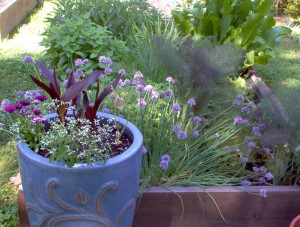DIY Veggie-tainers

Chives and fennel dress up these veggie-tainers while waiting for the next recipe. (Photo by Shannon Smith)
Move over, begonias. Find a home elsewhere, ferns. Homegrown veggies and herbs are taking over patios, one container at a time. Not everyone has space for an in-ground garden – nor does a busy household have the inclination. So, sowing the family’s produce in patio pots and deck planters is a growing alternative. Not only do container gardens have a small footprint, they require minimal maintenance. Most importantly, veggie-tainers, as they’re sometimes called, provide the convenience of fresh, tasty harvests just a few steps from the kitchen door.
Benefits of above-ground container gardens extend to those with special needs. Pot-sized planters give youngsters small-scale opportunities for green-thumb success. The ability to vary container heights also works well for seniors and people with ambulatory challenges.
No need to worry about unsightly appearances, because veggie-tainers don’t compromise aesthetics. Colorful vegetables and textured herbs can be as attractive as flowers, especially when creatively displayed. Some flowers work well as companion plants, doubling as edibles or pollinator attractors. Guests lounging on the deck or patio also enjoy summer’s breeze as it carries the scents of fragrant herbs and sun-ripened vegetables.
Creating veggie-tainers
The first, and perhaps foremost decision with container gardening is location. Vegetables typically require six to eight hours of sunshine per day, though some leafy varieties need less. The area being considered should have easy access to water and not block play areas or pathways.
Next, match the right container with the right plant. Root vegetables, such as beets and carrots, require deeper pots than shallow-rooted plants, like lettuce. Why not rev up the imagination and recycle at the same time? Open-top gutters, forgotten wheelbarrows, abandoned toy wagons and galvanized-tin tubs can be re-purposed as interesting vegetable-and-herb planters. A bicycle basket with a coconut liner, colorful galoshes, antique wooden boxes and hanging shoe organizers with pockets are not only functional, they’re fun. Just make sure the found objects hold sufficient water, allow drainage and don’t absorb too much sunlight, which can overheat and scorch some plants.
Moveable planters, as well as those placed atop wheeled bases, offer flexibility throughout the growing season. Plants with similar sun-and-water needs can be grouped together or easily moved for watering and maintenance. Bricks or smooth stones can be arranged to raise the containers, making them easier to reach and limiting drainage discoloration of deck and patio surfaces.
A soil blend can be purchased, or DIYers can combine compost, soilless mix and fine mulch. Coarse sand (unlike play sand) should be added for plants that prefer fast-draining soil, such as lavender or rosemary. For organic gardeners, an application of fish-emulsion works as an effective fertilizer.
Though mini-tomatoes may be the most-recognized container-grown veggie, there’s no need to stop there! Options for veggie-tainers are ever increasing as hybridizers introduce more and more compact plant cultivars. Keep in mind that containers also help control aggressive plants, such as mint. Just make sure the entire pot is dedicated to the greedy one, since it probably will smother out any companion plants.
Tips
- If a container is extra-large, fill the bottom with packing peanuts or nontoxic fillers before adding soil. The plants won’t be affected, and the pot will weigh considerably less.
- When a desirable container lacks drainage, drill holes in the bottom or sides before adding potting mix.
- If overwintering a container outside, make sure it is frost-proof. Or, move it to a partially sheltered area and wrap the container with bubble-wrap to help protect the plant roots.
- After cool-season vegetables and herbs are harvested, veggie-tainers can be refreshed for round two: warm-season gardening. If there is any sign of fungus or insects, it’s best to thoroughly sanitize the planter and use fresh soil mix before succession planting.
- Vegetables that might not work well in containers are corn, grapes, cabbage and traditional-sized melons.
This article first appeared in the Richmond Times-Dispatch, April 2016. Thanks to Horticulturist Heather Veneziano who contributed to this article.
